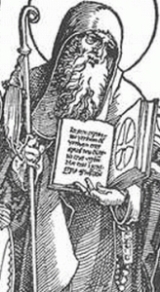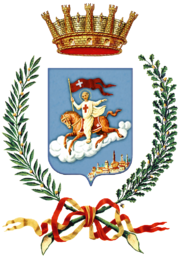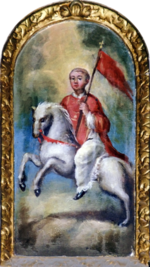
Saint Severinus
Encyclopedia
Severinus of Noricum is a Roman Catholic saint, known as the "Apostle to Noricum
". It has been speculated that he was born in either Southern Italy or in the Roman province of Africa, after the death of Attila in 453. Severinus himself refused to discuss his personal history before his appearance along the Danube
in Noricum. However, he did mention experiences with eastern desert monasticism
, and his vita
draws connections between Severinus and St. Anthony of Egypt
.
Saint Severinus of Noricum is not to be confused with Severinus of Septempeda, the brother of Saint Victorinus of Camerino, and a bishop of Naples, whose feast day is celebrated on the same day, January 8.
in Noricum and Bavaria
, preaching Christianity
, procuring supplies for the starving, redeeming captives and establishing monasteries at Passau
and Favianae, and hospices in the chaotic territories that were ravaged by the Great Migrations
, sleeping on sackcloth and fasting severely. His efforts seem to have won him wide respect, including that of the Germanic chieftain Odoacer
. Eugippius credits him with the prediction that Odoacer would become king of Rome
. However, Severinus warned that Odoacer would rule not more than fourteen years.
 Severinus also supposedly prophesied the destruction of Astura
Severinus also supposedly prophesied the destruction of Astura
, Austria
by the Huns under Attila. He established refugee centers for people displaced by the invasion, and founded monasteries to re-establish spirituality and preserve learning in the stricken region.
He died at in his monastic cell at Favianae while singing Psalm 150. Six years after his death, his monks were driven from their abbey, and his body was taken to Italy
, where it was at first kept in the Castel dell'Ovo
, Naples, then eventually interred at the Benedictine
monastery
rededicated to him, the Abbey of San Severino near Naples.
Severinus was the childhood guardian and spiritual father of St. Anthony the Hermit
.
 Paul the Deacon
Paul the Deacon
, in his 8th-century History of the Lombards, mentions the monastery founded by Severinus at Eiferingen, at the foot of the Kahlenberg
, not far from Vienna:
The Vita of Severinus was written by Eugippius
. Beyond Eugippius' work, the only other contemporary source that mentions Saint Severinus is the Vita beati Antonii by Magnus Felix Ennodius
, bishop of Pavia.
In the History of the Decline and Fall of the Roman Empire, Edward Gibbon
notes that the disciples of Saint Severinus were invited by a "Neapolitan lady" to bring his body to the villa in 488, "in the place of Augustulus, who was probably no more." The villa was converted into a monastery before 500 to hold the saint's remains.
Martin Luther
made reference to St. Severinus in point 29 of his famous Ninety-Five Theses suggesting that it is unclear whether all of the souls in purgatory desire to be brought out from it.
Noricum
Noricum, in ancient geography, was a Celtic kingdom stretching over the area of today's Austria and a part of Slovenia. It became a province of the Roman Empire...
". It has been speculated that he was born in either Southern Italy or in the Roman province of Africa, after the death of Attila in 453. Severinus himself refused to discuss his personal history before his appearance along the Danube
Danube
The Danube is a river in the Central Europe and the Europe's second longest river after the Volga. It is classified as an international waterway....
in Noricum. However, he did mention experiences with eastern desert monasticism
Christian monasticism
Christian monasticism is a practice which began to develop early in the history of the Christian Church, modeled upon scriptural examples and ideals, including those in the Old Testament, but not mandated as an institution in the scriptures. It has come to be regulated by religious rules Christian...
, and his vita
Biography
A biography is a detailed description or account of someone's life. More than a list of basic facts , biography also portrays the subject's experience of those events...
draws connections between Severinus and St. Anthony of Egypt
Anthony the Great
Anthony the Great or Antony the Great , , also known as Saint Anthony, Anthony the Abbot, Anthony of Egypt, Anthony of the Desert, Anthony the Anchorite, Abba Antonius , and Father of All Monks, was a Christian saint from Egypt, a prominent leader among the Desert Fathers...
.
Saint Severinus of Noricum is not to be confused with Severinus of Septempeda, the brother of Saint Victorinus of Camerino, and a bishop of Naples, whose feast day is celebrated on the same day, January 8.
Life
The mysterious high-born Severinus is first recorded as travelling along the DanubeDanube
The Danube is a river in the Central Europe and the Europe's second longest river after the Volga. It is classified as an international waterway....
in Noricum and Bavaria
Bavaria
Bavaria, formally the Free State of Bavaria is a state of Germany, located in the southeast of Germany. With an area of , it is the largest state by area, forming almost 20% of the total land area of Germany...
, preaching Christianity
Christianity
Christianity is a monotheistic religion based on the life and teachings of Jesus as presented in canonical gospels and other New Testament writings...
, procuring supplies for the starving, redeeming captives and establishing monasteries at Passau
Passau
Passau is a town in Lower Bavaria, Germany. It is also known as the Dreiflüssestadt or "City of Three Rivers," because the Danube is joined at Passau by the Inn from the south and the Ilz from the north....
and Favianae, and hospices in the chaotic territories that were ravaged by the Great Migrations
Migration Period
The Migration Period, also called the Barbarian Invasions , was a period of intensified human migration in Europe that occurred from c. 400 to 800 CE. This period marked the transition from Late Antiquity to the Early Middle Ages...
, sleeping on sackcloth and fasting severely. His efforts seem to have won him wide respect, including that of the Germanic chieftain Odoacer
Odoacer
Flavius Odoacer , also known as Flavius Odovacer, was the first King of Italy. His reign is commonly seen as marking the end of the Western Roman Empire. Though the real power in Italy was in his hands, he represented himself as the client of Julius Nepos and, after Nepos' death in 480, of the...
. Eugippius credits him with the prediction that Odoacer would become king of Rome
Rome
Rome is the capital of Italy and the country's largest and most populated city and comune, with over 2.7 million residents in . The city is located in the central-western portion of the Italian Peninsula, on the Tiber River within the Lazio region of Italy.Rome's history spans two and a half...
. However, Severinus warned that Odoacer would rule not more than fourteen years.

Astura
Astura could refer to:*Torre Astura, a former island of Lazio, Italy, containing Roman villas*Esla River, a river of Spain known to the Romans as Astura...
, Austria
Austria
Austria , officially the Republic of Austria , is a landlocked country of roughly 8.4 million people in Central Europe. It is bordered by the Czech Republic and Germany to the north, Slovakia and Hungary to the east, Slovenia and Italy to the south, and Switzerland and Liechtenstein to the...
by the Huns under Attila. He established refugee centers for people displaced by the invasion, and founded monasteries to re-establish spirituality and preserve learning in the stricken region.
He died at in his monastic cell at Favianae while singing Psalm 150. Six years after his death, his monks were driven from their abbey, and his body was taken to Italy
Italy
Italy , officially the Italian Republic languages]] under the European Charter for Regional or Minority Languages. In each of these, Italy's official name is as follows:;;;;;;;;), is a unitary parliamentary republic in South-Central Europe. To the north it borders France, Switzerland, Austria and...
, where it was at first kept in the Castel dell'Ovo
Castel dell'Ovo
Castel dell'Ovo is a castle located on the former island of Megaride, now a peninsula, on the gulf of Naples...
, Naples, then eventually interred at the Benedictine
Benedictine
Benedictine refers to the spirituality and consecrated life in accordance with the Rule of St Benedict, written by Benedict of Nursia in the sixth century for the cenobitic communities he founded in central Italy. The most notable of these is Monte Cassino, the first monastery founded by Benedict...
monastery
Monastery
Monastery denotes the building, or complex of buildings, that houses a room reserved for prayer as well as the domestic quarters and workplace of monastics, whether monks or nuns, and whether living in community or alone .Monasteries may vary greatly in size – a small dwelling accommodating only...
rededicated to him, the Abbey of San Severino near Naples.
Severinus was the childhood guardian and spiritual father of St. Anthony the Hermit
Anthony the Hermit
Anthony the Hermit , also known as Antony of Lérins, is a Christian saint. Anthony was born in Italy in the late 5th century, and raised from the age of eight by his relative St. Severinus...
.
Accounts of his life

Paul the Deacon
Paul the Deacon , also known as Paulus Diaconus, Warnefred, Barnefridus and Cassinensis, , was a Benedictine monk and historian of the Lombards.-Life:...
, in his 8th-century History of the Lombards, mentions the monastery founded by Severinus at Eiferingen, at the foot of the Kahlenberg
Kahlenberg
Kahlenberg is a mountain located in the 19th District within Vienna, Austria .-General:Kahlenberg lies in the Wienerwald and is one of the most popular destinations for day-trips from Vienna, offering a view over the entire city. Parts of Lower Austria can also be seen from Stefaniewarte at the...
, not far from Vienna:
The Vita of Severinus was written by Eugippius
Eugippius
Eugippius was a disciple and the biographer of Saint Severinus of Noricum. After the latter's death in 492, he took the remains to Naples and founded a monastery on the site of a 1st century Roman villa, the Castellum Lucullanum .While at Naples, Eugippius compiled a 1000-page anthology of the...
. Beyond Eugippius' work, the only other contemporary source that mentions Saint Severinus is the Vita beati Antonii by Magnus Felix Ennodius
Magnus Felix Ennodius
Magnus Felix Ennodius was Bishop of Pavia in 514, and a Latin rhetorician and poet.He was one of four fifth to sixth-century Gallo-Roman aristocrats whose letters survive in quantity: the others are Sidonius Apollinaris, prefect of Rome in 468 and bishop of Clermont , Ruricius bishop of Limoges ...
, bishop of Pavia.
In the History of the Decline and Fall of the Roman Empire, Edward Gibbon
Edward Gibbon
Edward Gibbon was an English historian and Member of Parliament...
notes that the disciples of Saint Severinus were invited by a "Neapolitan lady" to bring his body to the villa in 488, "in the place of Augustulus, who was probably no more." The villa was converted into a monastery before 500 to hold the saint's remains.
Martin Luther
Martin Luther
Martin Luther was a German priest, professor of theology and iconic figure of the Protestant Reformation. He strongly disputed the claim that freedom from God's punishment for sin could be purchased with money. He confronted indulgence salesman Johann Tetzel with his Ninety-Five Theses in 1517...
made reference to St. Severinus in point 29 of his famous Ninety-Five Theses suggesting that it is unclear whether all of the souls in purgatory desire to be brought out from it.

